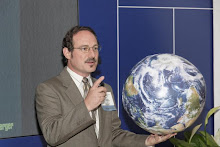Monday, May 18, 2009
The Carbon Lifecycle
Just off of Interstate 45 on the Freestone-Leon County Line, there is a place where you can see the entire anthropogenic carbon cycle in a single vista. Pull off at exit 180 and take the service road on the west side of the highway north about 5 miles. You will pass turn-ins for producing oil fields operated by operated by XTO, Pinnacle, and Anadarko. At the top of a rise just before the power lines cross the highway, you can pull into entrance 52 of Texas Westmoreland Coal Co.’s Jewett Mine, though not into the mine itself (mind the No Trespassing signs!) Walk to the fence and look down into the creekbed to your left and you can see slowly decomposing mats of leaf litter and other organic material in a slow-running stream, that left to their own devices, in many millenia, could be the source rock for a future gneration's hydrocarbon resource. Then look up and across the fence to the 35,000 acre lignite dragline operation that is continuously and voraciously scooping up the results of that process from the Eocene, and out to the horizon where the Limestone Electric Generating Station burns that stored energy to generate electricity and returns much of the carbon to the atmosphere as CO2. listen to the hum of the electricity in the high-tension wires over your head as the result of that energy process flows out to the cities and towns of southeast Texas, much of it to power equipment in the pumping oil wells that you passed just down the road. Now allow yourself to think about how much organic content is burned up every hour and how long it will take to renew, and you start to get a feel for the geologic time scale and how quickly we are altering it... I recommend that every Texas school child whose education is financed by oil and gas revenues have the opportunity to see first hand this cycle at work ...
Subscribe to:
Post Comments (Atom)

No comments:
Post a Comment